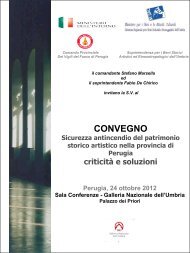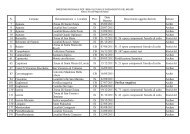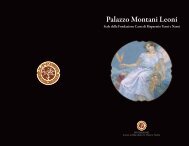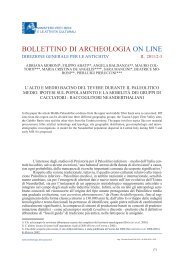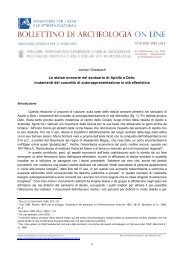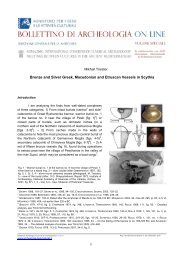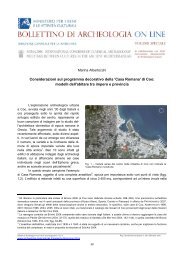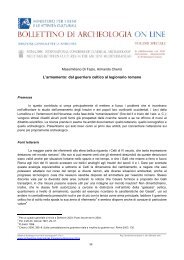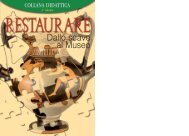Late Hellenistic Settlements in Hawrān (Southern Syria). Survival of ...
Late Hellenistic Settlements in Hawrān (Southern Syria). Survival of ...
Late Hellenistic Settlements in Hawrān (Southern Syria). Survival of ...
You also want an ePaper? Increase the reach of your titles
YUMPU automatically turns print PDFs into web optimized ePapers that Google loves.
XVII International Congress <strong>of</strong> Classical Archaeology, Roma 22-26 Sept. 2008<br />
Session: Formation d’une culture urba<strong>in</strong>e aux marges du désert syro-arabique: espaces urba<strong>in</strong>s et périurba<strong>in</strong>s<br />
(open air water tank) <strong>in</strong> the centre. The courtyard was probably used for keep<strong>in</strong>g herds 21 . Recent surveys<br />
conducted on the site have brought new evidence for the date <strong>of</strong> this settlement. Clandest<strong>in</strong>e excavations<br />
made by the locals have brought to light a large amount <strong>of</strong> sherds com<strong>in</strong>g from complete forms which were<br />
probably <strong>in</strong> situ when the casemates were plundered. This material is very homogeneous and allows us to<br />
date the construction and occupation <strong>of</strong> the site to a short period between the mid-2 nd c. and the mid-1 st c.<br />
BC. The absence <strong>of</strong> pottery f<strong>in</strong>ds on the surface <strong>in</strong> and around the site confirms a silentio the hypothesis <strong>of</strong> a<br />
very short-lived occupation. Among the material brought to light by the clandest<strong>in</strong>e excavations, the<br />
significant proportion <strong>of</strong> locally made table amphorae is perhaps to be related to the adoption <strong>of</strong> Helleniz<strong>in</strong>g<br />
social practices (banquet<strong>in</strong>g). At any rate, it <strong>in</strong>dicates the assimilation <strong>of</strong> a Hellenized repertoire by local<br />
potters <strong>in</strong> the 2 nd half <strong>of</strong> the 2 nd c. BC.<br />
Some 3 km south <strong>of</strong> this site, the village <strong>of</strong><br />
Sî‘ has a different but equally archaiz<strong>in</strong>g layout 22 .<br />
The site is located on a wide promontory and it<br />
covers approximately 5 ha (450 x 130 m). It is<br />
surrounded by a 5 to 8,5 m thick curved rampart,<br />
parts <strong>of</strong> which may have had casemates. The<br />
<strong>in</strong>side space is very densely built with relatively<br />
orthogonal blocks <strong>of</strong> houses. The first phase <strong>of</strong> the<br />
rampart and <strong>of</strong> the excavated houses dates back to<br />
the late 1 st c. BC 23 . Next to the village, on the west<br />
end <strong>of</strong> the promontory, lies a sanctuary <strong>in</strong>clud<strong>in</strong>g<br />
three temenè, the first <strong>of</strong> which (dedicated to<br />
Baalshamîn) was probably built <strong>in</strong> the last third <strong>of</strong><br />
the 1 st c. BC As shown by J. Dentzer-Feydy, its<br />
temple comb<strong>in</strong>es a local architectural layout with<br />
elements <strong>of</strong> Hellenized stone decoration 24 .<br />
Bollett<strong>in</strong>o di Archeologia on l<strong>in</strong>e I 2010/ Volume speciale G / G5 / 2 Reg. Tribunale Roma 05.08.2010 n. 330 ISSN 2039 - 0076<br />
www.archeologia.beniculturali.it<br />
5<br />
Leja (Trachonitis)<br />
In the neighbour<strong>in</strong>g volcanic plateau called<br />
Leja or Trachonitis, a recent survey supervised by<br />
F. Braemer has revealed an unexpected number <strong>of</strong><br />
human settlements <strong>of</strong> all proto-historic and historical<br />
periods 25 . Among these are some great tells,<br />
cover<strong>in</strong>g a surface <strong>of</strong> several hectares, with phases<br />
<strong>of</strong> occupation stretch<strong>in</strong>g from the Middle Bronze<br />
Age to the Early Roman period. Unfortunately, it is<br />
difficult to assess the nature and the importance <strong>of</strong> the <strong>Hellenistic</strong> occupation on these multi-period sites on<br />
the sole basis <strong>of</strong> survey results. However, recent <strong>Syria</strong>n excavations at Tell Debbeh, one <strong>of</strong> the major tells <strong>of</strong><br />
the region, suggest the existence <strong>of</strong> a late <strong>Hellenistic</strong> stratum (late 2 nd c. BC - 1 c. AD), subsequent to the<br />
abandonment <strong>of</strong> the site at the end <strong>of</strong> Iron Age II 26 Fig. 5 – Kreim aj-Janoûbi: plan <strong>of</strong> the visible rema<strong>in</strong>s.<br />
. Consequently, it is probable that a number <strong>of</strong> these<br />
ancient fortified tells still played a large role dur<strong>in</strong>g the late <strong>Hellenistic</strong> period.<br />
21 See ROUTLEDGE 2000, 59 for a discussion <strong>of</strong> this feature <strong>in</strong> similar Iron Age 1 settlements. The function <strong>of</strong> such central courtyards <strong>in</strong><br />
the Iron Age Negev “fortresses” has recently been demonstrated by geoarchaeological and isotopic analyses: see SHAHACK-GROSS,<br />
FINKELSTEIN 2008.<br />
22 DENTZER ET AL. 1985; VILLENEUVE Forthcom<strong>in</strong>g.<br />
23 DENTZER ET AL. 1985, 75–80; VILLENEUVE Forthcom<strong>in</strong>g.<br />
24 DENTZER-FEYDY 1986, 265–269.<br />
25 CRIAUD, ROHMER 2010; ROHMER 2010.<br />
26 ABOU ASSAF 2005.



